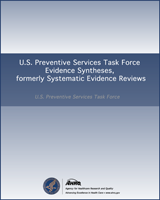Screening for Elevated Blood Lead Levels in Pregnant Women: A Systematic Review for the U.S. Preventive Services Task Force
Evidence Synthesis, No. 175
Authors
Investigators: Amy G. Cantor, MD, MPH, Marian S. McDonagh, PharmD, Ian Blazina, MPH, Jessica Griffin, MS, Sara Grusing, BA, and Rob Hendrickson, MD.ReadStructured Abstract
Background:
In 2006, the U.S. Preventive Services Task Force (USPSTF) recommended against routine screening for elevated blood lead levels (BLLs) in asymptomatic pregnant women (D recommendation).
Purpose:
To synthesize evidence on the effects of screening, testing, and treatment for elevated BLLs in pregnant women, to update a 2006 USPSTF systematic review.
Data Sources:
Cochrane CENTRAL and Cochrane Database of Systematic Reviews (through June 2018) and Ovid MEDLINE (1946 to June 2018), reference lists, and surveillance through December 5, 2018.
Study Selection:
English-language trials and observational studies of screening effectiveness, test accuracy, and benefits and harms of screening and interventions in asymptomatic pregnant women.
Data Extraction:
One investigator abstracted details about study design, patient population, setting, screening method, followup, and results. Two investigators independently applied prespecified criteria to rate study quality using methods developed by the USPSTF. Discrepancies were resolved through consensus.
Data Synthesis:
No studies directly evaluated clinical benefits and harms of screening pregnant women for elevated BLLs versus no screening, or how effectiveness of screening varies according to the gestational age at which screening is performed. One fair-quality study (N=314) evaluated the diagnostic accuracy of using a version of the Centers for Disease Control and Prevention screening questionnaire for lead exposure in children, modified for identifying pregnant women with elevated BLLs. The study used four out of five questions from the questionnaire and found a sensitivity of 75.7 percent and specificity of 46.2 percent. The most predictive single item was living in a home built before 1960. One fair-quality randomized, controlled trial from Mexico found that calcium supplementation in healthy pregnant women (N=670; mean baseline BLL, ~4 µg/dL) was associated with a reduction in serum lead levels compared with placebo (difference, 11%; p=0.004). No studies reported health outcomes or harms associated with interventions to reduce BLLs in asymptomatic pregnant women.
Limitations:
Limited to English-language articles; quality and applicability of studies were limited due to flawed study design, poor reporting of statistical outcomes, and loss to followup. Two studies addressed the Key Questions, with no evidence on effects of screening or interventions for elevated BLLs in pregnant women on health outcomes.
Conclusions:
Evidence on the benefits and harms of screening pregnant women for elevated BLLs is extremely limited, with no evidence on effects of screening or interventions for elevated BLLs in pregnant women on health outcomes.
Suggested citation:
Cantor A, McDonagh M, Blazina I, Griffin J, Grusing S, Hendrickson R. Screening for Elevated Lead Levels in Pregnant Women: A Systematic Review for the U.S. Preventive Services Task Force. Evidence Synthesis No. 175. AHRQ Publication No. 18-05245-EF-2. Rockville, MD: Agency for Healthcare Research and Quality; 2019.
This report is based on research conducted by the Pacific Northwest Evidence-based Practice Center (EPC) under contract to the Agency for Healthcare Research and Quality (AHRQ), Rockville, MD (Contract No. HHSA-290-2015-00009-I, Task Order No. 7). The findings and conclusions in this document are those of the authors, who are responsible for its contents, and do not necessarily represent the views of AHRQ. Therefore, no statement in this report should be construed as an official position of AHRQ or of the U.S. Department of Health and Human Services.
The information in this report is intended to help health care decisionmakers—patients and clinicians, health system leaders, and policymakers, among others—make well-informed decisions and thereby improve the quality of health care services. This report is not intended to be a substitute for the application of clinical judgment. Anyone who makes decisions concerning the provision of clinical care should consider this report in the same way as any medical reference and in conjunction with all other pertinent information (i.e., in the context of available resources and circumstances presented by individual patients).
This report may be used, in whole or in part, as the basis for development of clinical practice guidelines and other quality enhancement tools, or as a basis for reimbursement and coverage policies. AHRQ or U.S. Department of Health and Human Services endorsement of such derivative products may not be stated or implied.
None of the investigators have any affiliations or financial involvement that conflicts with the material presented in this report.
